Asteroid and Comet Space Probes
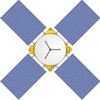

NEAR (Discovery 2)
Launched on 17 February 1996, NEAR (Near Earth Asteroid Rendezvous) became the first probe to orbit, then land on, an asteroid. NEAR returned over 160,000 images of its target, 433 Eros, the largest of the Near Earth Asteroids. NEAR was launched on a Delta-7925-8 rocket (right).
NEAR carried a variety of scientific instruments, including a magnetometer, a near-infrared spectrometer, an X-ray/gamma-ray spectrometer, a laser rangefinder, and a multispectral imager.
On 23 June 1997, while enroute to 433 Eros, NEAR conducted a flyby of the asteroid 253 Mathilde.
NEAR entered orbit around 433 Eros in February of 2000. Over the year, the spacecraft was able to study the entire surface of the asteroid.
In March of 2000, the NEAR mission was renamed "NEAR Shoemaker" in honor of Dr. Eugene Shoemaker. Dr. Shoemaker, an expert in planetary geology, participated in the development of the NEAR spacecraft. Shoemaker died in an automobile accident in 1997.
On 12 February 2001, the NEAR Shoemaker performed the first ever landing on an asteroid. During its descent, the spacecraft was able to acquire the highest resolution images ever taken of an asteroid. Although not designed to land, the touchdown was gentle enough that the spacecraft remained intact and was able to transmit data for a short period of time.
The highly successful NEAR Shoemaker mission acquired a large amount of scientific data, including over 160,000 images.
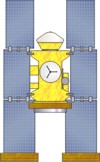

Stardust (Discovery 4)
Stardust - The Original Mission
Launched on 7 February 1999, Stardust's mission was to collect samples from the comet Wild 2's coma and return them to Earth. The spacecraft was launched on a Delta-7426 rocket (right).
Enroot to its planned rendezvous with Wild 2, the spacecraft conducted a flyby of the main-belt asteroid, 5535 Annefrank, in 2002.
A flyby of the target comet, Wild 2, was accomplished on 2 January 2004. During the flyby, Stardust extended a special particle collector to gather samples of material near the comet. The particle collector used a material known as 'aerogel' to catch tiny pieces of comet material.
The spacecraft also collected interstellar dust particles during the long cruise to Wild 2. The interstellar dust particles, as well as the coma particles from the Wild 2 encounter, were sealed in a special capsule. Equipped with a heat shield and parachute, the Earth-return capsule successfully landed in the United States on 15 January 2006.
These samples represent the first comet coma samples, and the first interstellar dust particles, to be returned to Earth for study.
In addition to particle collection, the Stardust spacecraft was fitted with several scientific experiments, including a Comet and Interstellar Dust Analyzer (CIDA), a Dust Flux Monitor (DFM), and a Navigation Camera (NavCam). These instruments collected scientific data during the flyby of Wild 2.
Stardust (Sample Return Capsule)
Stardust sample return capsule on display at the National Air and Space Museum. These are photos of the actual return capsule. (Photos: Richard Kruse, 2008)






Stardust-NExT
After completing its primary mission, the still healthy Stardust spacecraft was given a new mission. Named Stardust-NExT (New Exploration of Tempel 1), the spacecraft was re-targeted for a rendezvous with the comet Temple 1. The spacecraft conducted a flyby of Temple 1 on 14 February 2011. Examining two comets with the same spacecraft and instruments provided an opportunity to compare and contrast the characteristics of each comet.
Temple 1 was previously investigated by the Deep Impact mission. Another Discovery Program mission, Deep Impact struck the comet with a 770 lb impactor. The Deep Impact spacecraft photographed and analyzed the impact plume to gather data about the comets composition. The fast speed of the flyby, along with the cloud of impact debris, prevented the Deep Impact probe from directly imaging the impact crater. The Stardust-NExT flyby was able to image the region near the impact crater. Photos of the crater should reveal important clues about the structure and composition of comets.
End of Mission
Its mission complete, the spacecraft was commanded to turn off its transmitter in March, 2011.
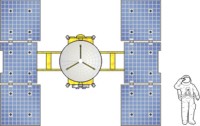
Hayabusa (Muses-C)
Hayabusa was a Japanese mission to orbit an asteroid, collect samples from the asteroids surface, and return the samples to Earth for study.
25143 Itokawa
The target for the Hayabusa mission, 25143 Itokawa, is an asteroid measuring approximately 540 meters by 310 meters by 250 meters, with an orbital period of 1.52 years
The asteroid was discovered on 26 September 1998 by the Lincoln Near-Earth Asteroid Research (LINEAR) Team.
The asteroid was giving the designation 'Asteroid 1998SF36'.
In 2003, the International Astronomical Union (IAU), named the asteroid for Professor Hideo Itokawa.
Professor Itokawa, an aerospace engineer, pioneered the development of solid fueled rockets.
nown as Dr. Rocket in Japan, Itokawa played an instrumental role in early Japanese space exploration.
Professor Itokawa died in 1999.

The Rocket
Hayabusa was launched on the M-V-5 booster (illustration at right) on 9 May 2003 from the Kagoshima launch center.
The M-V rocket was the largest and most capable of the Japanese Mu series of rockets.
The solid fueled rocket measured 30.8 meters tall and 2.5 meters in diameter. The M-V rocket was used primarily for scientific missions.
In addition to the Hayabusa asteroid mission, M-V rockets launched a number of astronomy satellites.
Of the seven rockets launched, six were successes.
The Mission
Hayabusa, originally called Muses-C, was a pioneering sample return mission, powered by a highly efficient, ion propulsion system.
If all went well, the spacecraft would rendezvous with the asteroid, 25143 Itokawa,
survey its surface from a station keeping position, conduct several landings on the surface,
collect samples, lift off and return the samples to Earth.
The spacecraft was designed to collect samples from three areas on the asteroids surface.
Three mirrored balls, one for each landing approach, were carried.
As the spacecraft approached the asteroid, one of the highly reflective balls would be dropped to the surface.
The reflection from the ball would show up clearly in images taken by onboard cameras.
Analyzed by onboard computers, the balls would provide fixed reference points to aid
navigation during the final approach and sample collection.
Near the surface, a collection horn, extending from the bottom of the spacecraft, would contact the surface.
A small metal projectile would then be fired into the surface, within the cone.
Asteroid material, thrown up by the impact, would be funneled into a collection device.
The spacecraft carried a small surface lander, known as Minerva.
Minerva was designed to be deployed as Hayabusa approached the asteroid.
Minerva was not part of the sample collection system.
In addition to Minerva, Hayabusa carried a number of instruments to image and analyze the asteroid's surface.
Included was a Light Detection and Ranging Instrument (LIDAR), an X-Ray Fluorescence Spectrometer (XRS), a Near Infrared Spectrometer (NIRS), a Telescopic Camera (AMICA), and a Wide-View Camera (ONC-W).
Problems Along the Way
The Hayabusa spacecraft experienced its share of problems.
Exposure to a solar flare early in the mission degraded its solar panels,
resulting in less power available for its electric propulsion system.
Operations were further hampered when a reaction wheel failed in July 2005.
Another reaction wheel failure, in September 2005, left the spacecraft with only one functioning wheel,
forcing the spacecraft to depend more on chemical thrusters to maintain attitude.
Hayabusa rendezvoused with Itokawa on 12 September 2005.
The spacecraft spent several weeks mapping the asteroid, from station keeping positions nearby.
On 12 November 2005, Hayabusa, during a practice approach, deployed the small Minerva lander.
Unfortunately, Minerva was released at the wrong time. Contact was lost and it probably missed the asteroid completely.
The first surface touch down occurred on 20 November 2005.
This was the first time a spacecraft made a controlled landing and take-off from an asteroid.
Unfortunately, the spacecraft was not able to collect a sample on this landing. A second landing took place on 26 November 2005.
Initial indications were that a sample was collected. Later telemetry, however, indicated part of the sample collection system might not have worked properly. It was unclear if any samples were collected.
All communication with Hayabusa was lost on 9 December 2005.
Contact was not made again until March 2006. Apparently a chemical fuel leak, in the bi-propellant fuel system, caused the spacecraft to lose attitude control. Unable to stabilize itself, the spacecraft could not aim its antenna at Earth for a period of time.
On 25 April 2007, the spacecraft started the long journey back to Earth.
Despite the failure of two of three reaction wheels, degraded solar panels, a fuel leak, problems with the ion propulsion system, and a number of other anomalies, the spacecraft is very near to completing its mission. Scientists were unsure if the spacecraft actually collected material from the asteroids surface.
Return to Earth
The Hayabusa re-entry capsule returned to Earth in June, 2010.
Using parachutes, the capsule landed safely near Woomera, Australia.
Several hundred dust particles, believed to be from Itokawa, were recovered from within the capsule.
Analysis of the samples is underway.
The Hayabusa mission provided invaluable data about the surface features and composition of asteroid Itokawa.
Techniques pioneered on this mission are certain to be beneficial for future sample return missions.


CONTOUR (Discovery 6)
Launched on 3 July 2003, CONTOUR (Comet Nucleus Tour) was planned to rendezvous with and explore two diverse comets. Unfortunately, CONTOUR failed several weeks after launch.
CONTOUR was launched on a Delta-7425 rocket (right).
The planned targets for CONTOUR were comets Encke and Schwassmann-Wachmann-2. The spacecraft would have taken high resolution images and conducted gas and dust analyses at each comet.
CONTOUR was successfully launched into Earth orbit. Several weeks later, on 15 August 2003, the probe was scheduled to fire a rocket to propel itself out of Earth orbit. No contact was made with the spacecraft after the scheduled rocket firing. Imagery from other sources seems to indicate that the vehicle exploded during the engine firing.
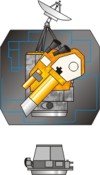

Deep Impact (Discovery 7)
Launched on 12 January 2005, the Deep Impact mission conducted a flyby of Comet Tempel 1. Prior to the flyby, a large 770 pound impactor was released. As planned, the impactor struck the comet at a speed of 23,000 miles per hour, creating a crater and ejecting comet material into space. From a safe distance, the main spacecraft photographed the impact and resulting plume.
Deep Impact was launched on a Delta-7925 rocket (right).
The comet Temple 1 was discovered by Ernst Tempel in 1867. The comet orbits the Sun every five and a half years. The Stardust spacecraft, having completed its primary mission in 2006 has been given a new mission. Renamed Stardust-NExT (New Exploration of Tempel 1), the spacecraft has been retargeted for a flyby of comet Temple 1 in February, 2011. If all goes as planned, Stardust-NExT should be able to image the impact crator left by Deep Impact.
After successfully completing its primary mission, the Deep Impact spacecraft has been retasked. Now known as EPOXI, the spacecraft has been given two new missions. The first mission, known as EPOCH (Extrasolar Planet Observation and Characterization), involves using sensors on the spacecraft to periodically observe several planets orbiting distant stars. The second new mission, known as DIXI (Deep Impact eXtended Investigation) has targeted the spacecraft for a close flyby of comet Hartley 2. The flyby is scheduled for 4 November 2010.
Retargeting existing spacecraft, that have completed their primary mission, for new and scientifically interesting assignments represents significant cost savings.


Dawn (Discovery 9)
The Dawn spacecraft, launched on 26 September 2007, was designed to orbit two of the largest bodies in the main asteroid belt - Ceres and Vesta. The Dawn spacecraft utilizes solar powered ion thrusters for propulsion.
Dawn was launched on a Delta-7925H rocket (right).
Vesta
Dawn rendezvoused with Vesta in 2011. The spacecraft entered orbit and is currently conducting scientific operations. The spacecraft is scheduled to leave Vesta in 2012.
Ceres
If all goes as planned, the Dawn spacecraft will reach Ceres in 2014.
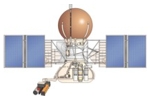

Vega
Two Vega probes were launched by the Soviet Union in 1984. Each probe deployed a lander and balloon at Venus, then performed a flyby of Comet Halley. Each mission was launched on a Proton rocket (right).
Instruments carried on the flyby spacecraft included a television system (TVS), a three-channel spectrometer (TKS), an infrared spectrometer (IKS), a dust mass spectrometer (PUMA), two dust particle Counters (SP-1) and (SP-2), a neutral gas mass spectrometer (ING), a plasma energy analyzer (PLASMAG), a energetic particle analyzer (TUNDE-M), a magnetometer (MISCHA), two Wave and plasma analyzers (APV-N) and (APV-V), a dust particle detector (DUCMA), and an energetic particle experiment.
Vega 1
Vega 1 was launched on 15 December 1984. Venus encounter and lander release occurred in June 1985. The encounter with Comet Halley occurred on 6 March 1986.
Vega 2
Vega 2 was launched on 20 December 1984. Venus encounter and lander release occurred in June 1985. The encounter with Comet Halley occurred on 9 March 1986.
Vega Spacecraft
Vega Spacecraft on display at the Udvar Hazy Center. (Photos: Richard Kruse, 2008)
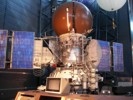
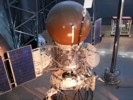

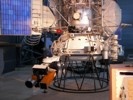
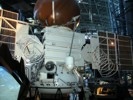
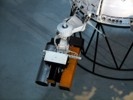
Venus Balloon and Instrument Package





International Cometary Explorer (ICE)
International Sun-Earth Explorer 3 (ISEE-3) was launched on 12 August 1978 on a Delta-2914 rocket. The launch took place at launch complex LC-17B, Cape Canveral, USA.
ISEE-3 was part of a three spacecraft magnetospheric study. Instruments included a Gamma-Ray Burst Spectrometer, and an X-ray Spectrometer.
After completing its original mission in 1982, the spacecraft was renamed "International Cometary Explorer (ICE)" and maneuvered, using thrusters and gravity assists, to an intercept course with comet 21P/Giacobini-Zinner.
The spacecraft conducted a flyby of 21P/Giacobini-Zinner in September 1985.
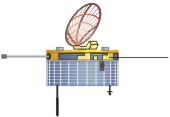

Sakigake
Sakigake was launched on 8 January 1985 on a Japanese M-3-SII rocket. The launch took place at Uchinoura Space Center, Japan.
The spacecraft carried three scientific instruments, the Solar wind ion monitor (SOW), the Plasma wave monitor (PWP), and the Magnetometer for solar wind and interplanetary space (IMF).
Sakigake conducted a fly-by of Comet P/Halley on 11 March 1986. Contact with the spacecraft was lost on 15 November 1995.
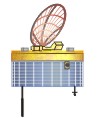

Suisei (Planet A)
Suisei was launched on 19 August 1985 on a Japanese M-3-SII rocket. The launch took place at Uchinoura Space Center, Japan.
The spacecraft carried two scientific instruments, an ultra-violet imager (UVI) and a solar wind observation instrument (ESP).
Suisei conducted a fly-by of Comet Halley on 8 March 1986. Contact with the spacecraft was lost on 15 November 1995.


Giotto
Giotto was launched on 2 July 1985 on an European Ariane 1 rocket. The launch took place at the space center in French Guiana.
Built and operated by the European Space Agency (ESA), Giotto was Europe's first deep space probe, and the first probe to obtain close-up images of a comet nucleus.
The Giotto probe conducted a flyby of comet Halley on 13 March 1986. A close flyby of comet 26P/Grigg-Skjellerup took place on 10 July 1992.

Deep Space 1
Deep Space 1 was launched on 24 October 1998 on a Delta-7326 rocket. The launch took place at launch complex LC-17A, Cape Canaveral, USA.
Deep Space 1 served as a test-bed for a number of high-risk technologies, including an ion propulsion system and solar concentrator arrays. During its mission, the spacecraft conducted flybys of several targets, including the asteroid 9969 Braille in July 1999, and the comet 19P/Borrelly in September 2001.
Operations ended on 18 December 2001


Rosetta
Rosetta was launched on 3 February 2004 on an Ariane 5 rocket.
The launch site was in Kourou, French Guiana.
Rosetta's primary mission was to rendezvous with, orbit, and send a lander to the surface of Comet 67P/Churyumov-Gerasimenko.
The decade long journey to the comet included a number of flybys.
The spacecraft made three fly-bys of Earth, in 2005, 2007, and 2009. A mars fly-by occurred in 2007.
The spacecraft also conducted flybys of two asteroids, 2867 šteins and 21 Lutetia.
2867 šteins
Rosetta observed the asteroid 2867 šteins during a flyby in 2008.
21 Lutetia
Rosetta observed the asteroid 21 Lutetia during a flyby in 2010.
Comet 67P/Churyumov-Gerasimenko
Rosetta entered orbit around Churyumov-Gerasimenko in August 2014.
In November, 2014, Rosetta deployed a lander, named Philae, that performed the first successful landing on a comet.
It's mission complete, the Rosetta spacecraft made a controlled impact on the comet's surface in September, 2016.
For more information about this highly successful mission, visit ESA's Rosetta website.
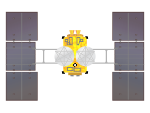

Hayabusa 2
Hayabusa 2 is Japanese mission to orbit an asteroid and return samples to Earth.
The mission was launched in November, 2014, on a H-IIA rocket.
The target for the Hayabusa 2 mission was the asteroid known as 162173 Ryugu.
The spacecraft arrived at the asteroid in 2018, with the samples returning safely to Earth in 2020.
The spacecraft is now in an extended mission, with plans to flyby two more asteroids.
For more information, visit JAXA's Hayabusa 2 website.
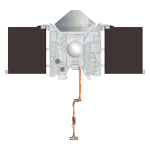

OSIRIS-REx
OSIRIS-REx is an American mission to orbit an asteroid, collect samples from the asteroids surface, and return the samples to Earth for study.
The mission name, OSIRIS-REx, is derived from "Origins, Spectral Interpretation, Resource Identification, Security-Regolith Explorer".
The mission was launched in September, 2016, from Cape Canaveral Air Force Station, on an Atlas V-411 rocket.
The spacecraft arrived at Bennu in 2018 and successfully collected a surface sample in 2020.
If all goes well, material samples collected from the asteroids surface will be returned to Earth in 2023.
For more information, visit NASA's OSIRIS-REx website.


Lucy
The NASA Lucy mission will investigate several Trojan asteroids and a main belt asteroid.
The mission is part of NASA's Discovery program of solar system exploration missions.
The mission was launched in October 2021, from Cape Canaveral Space Force Station,
on an Atlas V-401 rocket.
Scientific instruments include a visible imager, an infrared imaging spectrometer,
a long-range reconnaissance imager, and a thermal emission spectrometer.
Because the mission will be operating over 5 AU from the sun, the spacecraft requires large solar arrays.
For more information, visit NASA's Lucy website.


DART
DART, short for Double Asteroid Redirection Test was launched in November 2021 on a Falcon 9 rocket from Vandenberg Space Force Base.
In September 2022, the spacecraft entered the Didymos binary asteroid system and deliberately impacted Dimorphos, the smaller of two asteroids comprising the system.
The objective was to study the effects of a spacecraft impact on an asteroid's trajectory.
For more information about this highly successful mission, visit the DART website.


Hera
The Hera mission was developed by the European Space Agency and was launched in October 2024 on a
Falcon 9 rocket from Cape Canaveral Space Force Base.
Hera is intended to explore the Didymos binary asteroid system, with arrival planned for 2026
The Didymos binary asteroid system consists of two asteroids, Didymos being the larger one, and Dimorphos the smaller one.
Dimorphos was previously the target of NASA's DART impact mission in 2022.
Hera will study the Didymos system in detail, with a particular focus on the results of the DART impactor mission.
For more information about this mission, visit the Hera Mission website.
 Images by Richard Kruse are licensed under a Creative Commons Attribution-Noncommercial 3.0 United States License.
Images by Richard Kruse are licensed under a Creative Commons Attribution-Noncommercial 3.0 United States License.

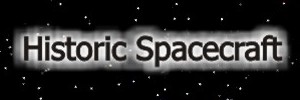
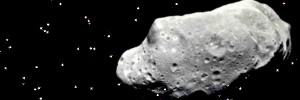


































 Images by Richard Kruse are licensed under a Creative Commons Attribution-Noncommercial 3.0 United States License.
Images by Richard Kruse are licensed under a Creative Commons Attribution-Noncommercial 3.0 United States License.